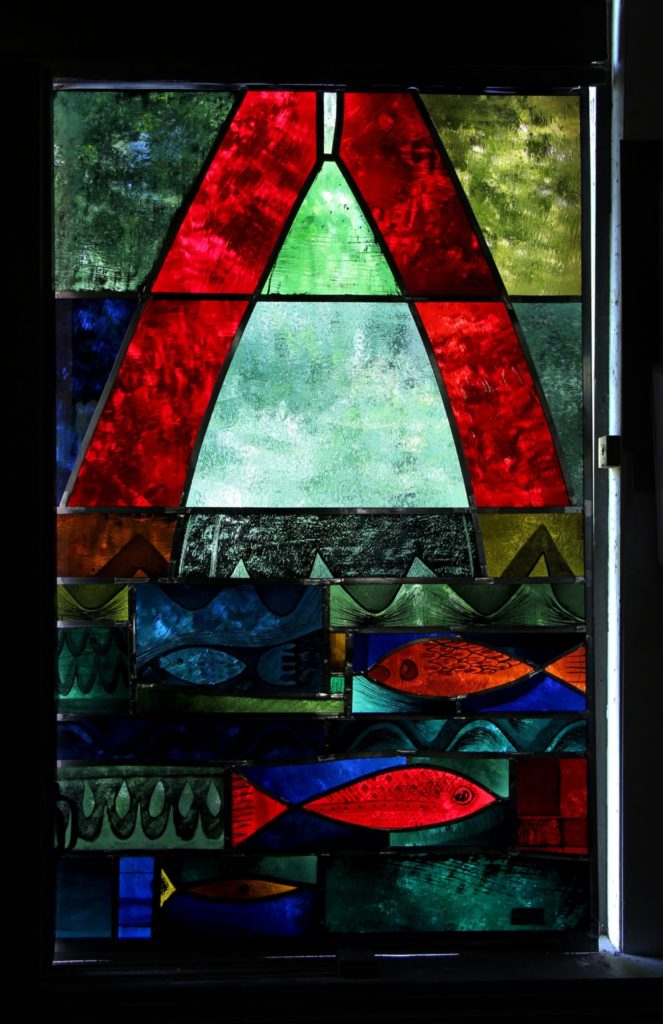Stained glass windows in buildings of worship have been described as a glimpse of heaven, and the windows in the university’s Danforth Chapel are no exception. But the view was shattered last fall when vandals smashed “The Genesis,” a window crafted by arguably the best stained-glass artist of our time. Sometime between 5 p.m. Saturday, Oct. 22 and 5:30 a.m., Sunday, Oct. 23, 2016, burglars broke into the chapel through the west-side, floor-to-ceiling window, shattering a two-foot by three-foot panel of the one-of-a-kind creation.
Now sunlight filters through the window once again, fully restored by the fifth generation of the family company that originally created it. The restored pane was installed by Facilities Management on June 15, making a masterpiece whole again.
Meticulous, complex restoration process
The restoration started with CSU Facilities Management picking through the rubble to find, package and ship buckets of thousands of extremely small shards of glass to St. Louis, where they were painstakingly pieced together to recreate the original work.

“All told, only about 15 percent of the window was salvaged,” said Aaron Frei, great-great grandson of Emil Frei, the founder of the company that created the window, and great-grandson of the company patriarch when the window was created in 1958. “The Genesis” was made by Robert Harmon, a stained glass artist who began working in Emil Frei’s studio in 1938. Harmon, who passed away in 2000, was a pioneer in modern, midcentury stained-glass work; he and his works appeared in publications such as Time magazine.
“It was in a much-destroyed state; everything was in shards. Little, bitty shards,” Frei said. “The largest pieces of glass were half an inch by a quarter of an inch, but only a few were that size. The vast majority were much smaller. Our first step was to put it together like a jigsaw puzzle.”
The shards were grouped by color. The Emil Frei & Associates Studio is the only company still using the glass color pallet depicted in “The Genesis.” The glass for the window is mouth-blown and made with techniques used in 12th century cathedrals, which is key to producing colors that are generally no longer found in modern stained glass.
The original glass was imported from Poland, France and Germany. Samples of the broken glass were sent to Germany, where a few remaining glassblowers trained in ancient techniques recreated the color, texture and depth of the original pieces.
Some of the glass also is painted with metal oxides fired into the glass. The brush strokes of the original artist also had to be mimicked and reapplied to the window, based on the puzzle-pieced original. As luck would have it, the Emil Frei Studio kept good records; the restoration process was based on Harmon’s original sketches, pattern and notes, which allowed artisans of the newly created 85 percent of the window to match the originals flawlessly.
Vandalism created exceptional restoration challenge
While the Emil Frei Studio has restored stained glass windows in the past, including restoring all of the windows in a Biloxi, Miss., church after Hurricane Katrina, the Danforth window will remain a memorable project.
“This was more difficult than many other restoration projects because the glass shards were smaller,” Frei said. “The vandalism was so severe; there was no window at all. What was left were simply shards. We spent four days sorting and piecing back together shards, alone.”
Once the shards were pieced together, replacement glass was cut to the original pattern, then painted with metal oxide, glazed together with lead, and soldered. The entire restoration project required more than 100 hours of work.
“The impressive thing is, while this is a very modern piece in design, the tradition and execution of the artwork is not. The amount of time that went into this piece is based on long-standing tradition, with techniques dating back to 1000 AD,” Frei said.

Danforth built for reflection, peace
“The Genesis” depicts a theme with symbols and concepts found in every religious faith — air, earth, fire and water. Deep and contemplative, it is heralded is an example of pioneering, modern stained glass by one of the best stained glass artists in history.
The Danforth Chapel is a non-denominational gathering place, designed by renowned architect James Hunter and built in 1953 for $60,000 on the north end of the Colorado State Oval. Hunter so loved the chapel that his ashes are entombed in a niche in the building’s wall.
Thought by many to be one of the most beautiful buildings on campus, it features copper doors and several panes of Harmon’s stained glass windows. It is the location of the John Quincy Phelps Memorial Garden, created in 2014 as a place of reflection. The chapel has hosted thousands of weddings, memorial services and other events.
The non-denominational chapel at 701 Oval Drive is open to the public from 7 a.m. to 8 p.m. weekdays except during special events or university holidays.
CSU police continue to seek information about the vandalism. Anyone with information should call 970-491-6425.